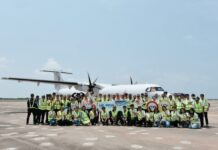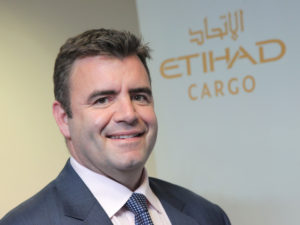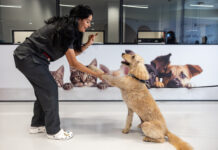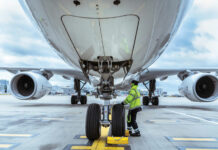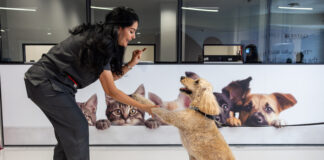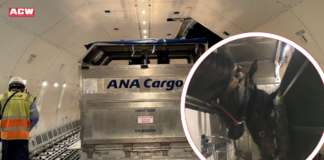

2016 was a topsy-turvy year for Middle East airfreight.
August saw just a 1.8 per cent increase in demand, the slowest since 2009 as the region was hit by weak volumes on Asian and North America routes. Increases in airfreight capacity, sea freight and world trade volatility were contributory factors.
The year ended strongly and according to the Airports Council International, cargo throughput in the Middle East was up 10.4 per cent in December and 5.8 per cent for the year.
Dubai International Airport was one of the star performers with cargo up 3.4 per cent to just under 2.6 million tonnes for 2016. Emirates Group subsidiary dnata closed the year with 419,133 cargo tonnes at the airport, up eight per cent on 2015.
Emirates SkyCargo is also powering forward. In late December, it revealed it was looking to expand its network of cargo destinations in the US with a new daily service to Fort Lauderdale in Florida – its 13th destination in the US.
The Boeing 777-200LR heading to Fort Lauderdale is offering up to 15 tonnes of bellyhold cargo capacity per flight. SkyCargo said the rationale was to open up trade opportunities with goods being moved including surgical and lab equipment, electronics, aerospace components and pharmaceuticals.
The group is also thinking more creatively. In November, it launched SkyWheels for the specialist transport of high value classic, luxury and sports cars. This includes door-to-door transportation of the vehicle from select origins and destinations in addition to export and import customs clearance processes.
It follows a similar service launched by Etihad Cargo last summer. Etihad offers drivers of luxury cars up to 20 per cent off air cargo rates and their seat with their car delivered “straight to their doorstep”.
Etihad Cargo senior vice president, David Kerr (pictured above) says the service was driven by demand in the Middle Eastern markets from people who “like to take their cars on holiday with them” or people relocating abroad.
He adds: “We carry vehicles predominantly from the UAE but also from neighbouring countries. The main destinations are Europe mainly the UK and Germany.”
It transported 250 cars in 2016 including Bugatti and Lamborghini sports cars. It also carries Formula 1 and Super Sport cars, for manufacturers who need to ship their new releases by air for car launches or auto shows.
“The attention to detail that goes into moving these cars is amazing – you don’t want to get one tiny scratch on it,” he states. “The 4WDs still have to go on a freighter aircraft as they have the bigger cargo doors which can accommodate larger vehicles.
“We have a combined fleet which means we operate freighters as well as passenger aircraft so we are able to accommodate any vehicle.”
Both Etihad and Emirates are tapping into more personalisation in air cargo. “One of the other services we offer which was driven by demand in this region is the transport of falcons,” Kerr explains.
“Falconry is hugely popular in the GCC countries and we ship thousands of them a year as cargo, or even in the cabin of the aircraft. When they go in the cargo hold they travel in IATA approved containers or on pallets in a temperature controlled, pressurised environment. The most popular destinations for our falcon traffic is within the region and the UK, Germany and Spain.”
However, overall in 2016, Etihad Cargo carried 592,700 tonnes, which was flat year-on-year. During the period, it expanded its freighter services to several new markets including Columbus Rickenbacker, Ohio in the US, the East Midlands and London Stansted; Copenhagen; Brussels; Addis Ababa and Casablanca in Africa; Colombo, Muscat, and Zhengzhou in China. It now has 15 freighter-only destinations.
“We saw some of the strength from the back of 2016 flow into 2017 but it is still a little early to talk definitively about the second quarter. There is nothing pointing to a major upswing but the good news is we are not seeing a decline,” says Kerr.
“Both Europe and the US are strong export markets for us thanks in no small part to their favourable exchange rates. The US is a very good market for us, but our capacity is limited. Our Rickenbacker freighter operation has been very successful.
“We also manage all of Airberlin’s capacity to the US including on major trade lanes such as Dusseldorf to JFK and Los Angeles and Berlin to JFK and Chicago, and can feed on to Abu Dhabi.”
So more customer focused services and US growth are helping Etihad and the Emirates cope with market pressures. What of Lufthansa?
Director of sales & handling for the Middle East & Iran, Thorsten Braun, says the UAE is a very competitive market at present. “The volumes aren’t going down but the cargo mix we are carrying is changing,” he says.
“Sea to air coming from China into Dubai and off to Europe is declining because there is more belly capacity at an affordable price and there are more rail freight trains heading into Europe from China with a big cargo capacity.
“We have managed to replace some of that missing cargo from China via Dubai, mainly garments, with other sea to air cargo from Sri Lanka, Bangladesh and Pakistan.”
He says Lufthansa is looking at working closer together with Far East or South East carriers to help drive more volumes in via Dubai to Europe and beyond and fill capacities.
“There are a lot of discussions going on around interlining,” Braun states. “How can we help get say fish from Sri Lanka to Europe? We can do it through Dubai or Kuwait through collaboration.”
In January, Lufthansa announced a new two weekly main-deck connection from Sharjah International Airport to Hong Kong operated with LCAG’s MD11 freighters. It is carrying a range of products from perishables, healthcare products, live animals, to general and special cargo.
“We want to make more efficient use of our existing resources and maximise our revenues,” Braun says. “It is doing well but Hong Kong is not the strongest import market in the world and the Middle East is not the strongest export market but we can make this a success.”



